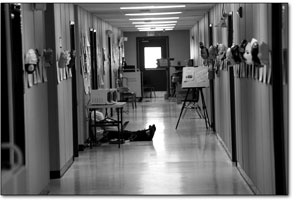 |
|
An Animas High School student sits in the hallway Tuesday afternoon, working on his computer. Charter schools like Animas, which is modeled after High Tech High in California, could get more funding from the state under the new law associated with Amendment 66./Photo by Steve Eginoire |
Getting schooled
Voters to decide on billion-dollar plan; plus 9-R board candidates and changes
by Tracy Chamberlin
The current education system in Southwest Colorado could be getting schooled this November with the potential for big changes on the ballot.
Voters are being asked to consider reshaping the structure of public education funding in Colorado with Amendment 66; reducing the size of the Durango school board with Question 3A; and electing several members for that board’s next session.
This week, the Telegraph breaks down these issues, examing the two ballot measures and giving readers a chance to meet the candidates vying for their votes.
It’s not just about the tax hike that would add a billion dollars to the public education coffers in Colorado. Amendment 66 also introduces several changes to the current funding system, essentially restructuring it.
The first step in the process was passing Senate Bill 213 this past spring.
|
How much would you pay? Under the Amendment 66, the income tax rate for Coloradans would go up either 5 or 5.9 percent. To figure out exactly how much that might be, residents can go online and enter in their taxable income at www.colorado.gov/cs/Satellite/CGA-LegislativeCouncil/CLC/1251644845398 |
Introduced by Sen. Mike Johnston, D-Denver, the 141-page law replaces the 1994 School Funding Act and changes how much each school district gets per student and why. It also attempts to address how the state can fill the budget gap in lean years and how to make the whole process more transparent.
Of course, the billion-dollar question for voters is the tax hike. Under the state’s Taxpayer Bill of Rights only voters can approve higher taxes, which is why Amendment 66, part of SB 213, is on the November ballot.
Currently, residents pay a flat rate of 4.63 percent on their income. The new rate would be two-tiered, meaning that higher incomes would be taxed at higher rates.
Those making under $75,000 would pay a rate of 5 percent and those more than $75,000 would pay a rate of 5.9 percent. For a Durango family making around $50,000, the uptick in taxes would be between $100 and $150 a year.
The fiscal school year runs from July to June, so in the first year, which would be 2013-14, these tax increases would mean an extra $452 million. The first full year in 2014-15 would bring in $950.1 million and that number would go up to more than $1 billion starting in 2015-16.
Then there’s the change to where all that money goes.
The new law restructures the formula for how much each student gets, channeling more money to early-childhood education, at-risk students and English-language learners. Durango is one of the districts that would ultimately benefit from this new formula, getting almost $500 more per student.
Another part of SB 213 is the creation of the State Educational Achievement Fund. With at least 43 percent of Colorado income and sales taxes going to education, this fund would be an account where monies collected during high times could sit until they are needed during lean times. Like a back-up plan, this is meant to give the state an option besides cutting school funding during a recession.
The law also provides additional funding for local innovative programs like longer school days and the creation of a website so everyone can view and track a school’s spending.
Supporters of the amendment and the new law tout the potential uses for the additional funding, like hiring more teachers and reducing class size, reinstating programs cut during the recession, and professional development for teachers and administrators.
Among those supporters is the Durango school board, as well as the Montezuma-Cortez and Dolores school boards.
Opponents, on the other hand, note that although the money could go to these endeavors, there is no enforcement or accountability in the law and therefore no guarantees. They cite concerns that it could even be used to cover the almost $24 billion shortfall in the Public Employee's Retirement Association fund.
Among those opponents are the Independence Institute and the National Federation of Independent Businesses.
On one side of the 66 debate is Colorado Commits to Kids at coloradocommits.com, which supports the amendment. The other side is Coloradans for Real Education Reform, at www.coforrealedreform.com, which opposes the measure.
